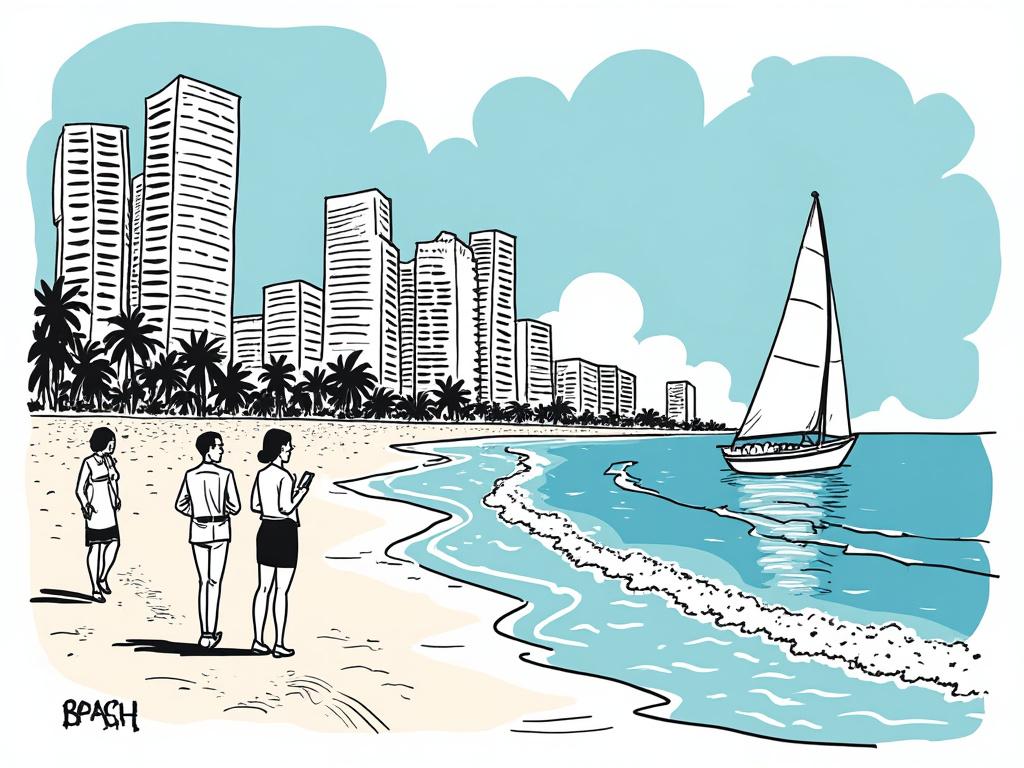
Greece’s Hidden Paradise: Discovering the Mediterranean’s Most Spectacular Beaches
Reading time: 8 minutes
Ever dreamed of crystal-clear turquoise waters lapping against pristine white sand while ancient myths whisper through olive groves nearby? Greece delivers this fantasy across thousands of stunning coastlines. Whether you’re seeking dramatic cliffs, secluded coves, or vibrant beach towns, the Greek islands and mainland offer beach experiences that consistently rank among the world’s finest.
Table of Contents
- Why Greek Beaches Stand Apart
- Iconic Beach Destinations You Can’t Miss
- Hidden Gems: Secret Beaches Worth the Journey
- Practical Beach-Hopping Strategies
- Beach Comparison Guide
- Living the Dream Year-Round
- Your Greek Beach Adventure Starts Here
- Frequently Asked Questions
Why Greek Beaches Stand Apart
Greece isn’t just another Mediterranean destination—it’s a tapestry of over 6,000 islands and 13,676 kilometers of coastline, each offering distinct personalities. What makes Greek beaches extraordinary isn’t just their Instagram-worthy aesthetics; it’s the seamless blend of natural beauty, rich history, and authentic cultural experiences.
The Greek Beach Experience:
- Volcanic black sand beaches contrasting with snow-white limestone cliffs
- Archaeological sites literally steps from pristine swimming spots
- Family-run tavernas serving fresh seafood caught that morning
- Water temperatures reaching 25°C (77°F) from June through September
According to the Greek National Tourism Organization, over 400 Greek beaches hold Blue Flag certification—more than any other Mediterranean country. This isn’t coincidence; it’s the result of Greece’s commitment to preserving its natural maritime heritage while providing world-class facilities.
Iconic Beach Destinations You Can’t Miss
Santorini: Where Volcanic Drama Meets Azure Beauty
Santorini’s beaches tell the story of ancient volcanic eruptions through their distinctive black and red sands. Red Beach (Kokkini Paralia) remains the island’s crown jewel, where towering red cliffs create a natural amphitheater around a small pebble beach. The contrast between the deep crimson rocks and brilliant blue Aegean creates photography that seems almost surreal.
Insider tip: Visit Red Beach early morning or late afternoon to avoid crowds and capture the most dramatic lighting. The 10-minute hike from Akrotiri village requires sturdy shoes but rewards you with one of Greece’s most unique beach experiences.
Mykonos: Cosmopolitan Energy Meets Traditional Charm
Paradise Beach and Super Paradise Beach have earned international reputations as party destinations, but Mykonos offers quieter alternatives. Agios Sostis Beach provides a refreshing contrast—no organized facilities, just pure golden sand, crystal-clear water, and a single traditional taverna serving grilled fish.
The transformation is remarkable: During peak season, Paradise Beach hosts international DJs and attracts thousands of visitors, while Agios Sostis maintains its authentic Greek island atmosphere just 15 minutes away.
Crete: Diversity Across Greece’s Largest Island
Balos Lagoon consistently appears on “world’s best beaches” lists, and experiencing it firsthand reveals why. This isn’t just a beach—it’s a natural phenomenon where three seas meet, creating a lagoon of impossible turquoise shades. The white sand contains tiny shells and coral fragments, giving it an almost tropical appearance rare in the Mediterranean.
Reaching Balos requires commitment: either a 20-minute boat ride from Kissamos or an hour-long hike across rugged terrain. This effort filters out casual visitors, preserving the lagoon’s pristine character for those willing to make the journey.
Hidden Gems: Secret Beaches Worth the Journey
Navagio Beach, Zakynthos: The Shipwreck That Launched a Thousand Trips
Navagio Beach (Shipwreck Beach) represents everything dramatic about Greek coastlines. The rusted hull of the MV Panagiotis, wrecked in 1980, sits on blindingly white pebbles surrounded by 200-meter limestone cliffs. The beach is accessible only by boat, which maintains its secluded atmosphere despite its fame.
The surrounding cliffs provide multiple viewing platforms, but the beach experience itself requires planning. Boat tours from Zakynthos town run hourly during summer, with the best swimming conditions typically between 11 AM and 4 PM when the sun illuminates the entire cove.
Myrtos Beach, Kefalonia: Where Hollywood Comes to Film
Myrtos Beach earned its reputation through countless film productions, but visitors quickly discover why directors choose this location. The 12-kilometer crescent of white pebbles curves between dramatic cliffs, while the water shifts from deep sapphire to brilliant turquoise depending on depth and lighting.
The beach presents interesting challenges: the pebbles can be uncomfortable for extended sunbathing, and the sea floor drops quickly, making it less suitable for non-swimmers. However, these same characteristics contribute to the water’s remarkable clarity and the beach’s untouched appearance.
Egremni Beach, Lefkada: The Blue That Defies Description
Before a 2015 earthquake made access more challenging, Egremni Beach was already considered a hidden gem. Today, reaching this 2.5-kilometer stretch of white sand requires either a boat trip or a demanding hike, but the payoff justifies the effort. The water color here seems almost artificial—a blue so vivid it challenges camera sensors and human perception alike.
Practical Beach-Hopping Strategies
Timing Your Visit:
Greek beaches transform dramatically throughout the year. July and August bring peak crowds and highest prices, but also the warmest water and most reliable weather. May, June, and September offer the sweet spot: pleasant temperatures, fewer crowds, and significantly lower accommodation costs.
Transportation Logistics:
Island-hopping requires strategic planning. The Cyclades islands (including Santorini and Mykonos) connect efficiently via ferry networks, with high-speed services reducing travel times. For remote beaches like Balos Lagoon or Navagio, rental cars provide flexibility that organized tours cannot match.
Common Challenge: Beach Accessibility
Many of Greece’s most beautiful beaches require effort to reach. This isn’t accidental—it’s what preserves their natural character. Research access requirements beforehand: some beaches require boats, others need hiking, and many have limited or no facilities.
Beach Comparison Guide
| Beach | Accessibility | Crowd Level | Facilities | Best For |
|---|---|---|---|---|
| Balos Lagoon, Crete | Moderate | Medium | Minimal | Photography |
| Paradise Beach, Mykonos | Easy | High | Full | Nightlife |
| Navagio Beach, Zakynthos | Boat Only | High | None | Adventure |
| Myrtos Beach, Kefalonia | Easy | Medium | Basic | Relaxation |
| Agios Sostis, Mykonos | Moderate | Low | Minimal | Authenticity |
Beach Popularity Rankings (by Visitor Numbers)
Living the Dream Year-Round
For those captivated by Greece’s coastal beauty, the dream of year-round Mediterranean living is more accessible than many realize. The Greek property market offers compelling opportunities, from traditional island homes steps from pristine beaches to modern developments with private sea access.
Consider Maria and Thomas, a German couple who discovered Paros during a beach-hopping vacation in 2019. Enchanted by Chrysi Akti beach’s golden sands and the island’s authentic atmosphere, they purchased a traditional Cycladic house within walking distance of multiple beaches. Today, they split their time between Hamburg and Paros, renting their property to fellow beach enthusiasts during peak season.
The Greek property market presents unique advantages for beach lovers. Many coastal properties come with traditional architectural features—whitewashed walls, blue shutters, private terraces overlooking the sea—while offering modern amenities. For those serious about making Greece their permanent or seasonal home, exploring property for sale in greece reveals options ranging from beachfront apartments to traditional island houses with sea views.
Investment Considerations:
- Greek Golden Visa program offers EU residency for property investments over €250,000
- Many islands experience strong rental demand during tourist season
- Property prices remain significantly lower than comparable French or Italian coastal areas
- Year-round community presence varies significantly between islands
Your Greek Beach Adventure Starts Here
Your Strategic Beach-Hopping Roadmap:
Phase 1: Foundation Building (Months 1-2 Before Travel)
- Research ferry schedules and book accommodations for shoulder season visits
- Download offline maps for remote beach locations
- Connect with local Facebook groups for real-time beach conditions and hidden spot recommendations
Phase 2: Experience Optimization (During Your Trip)
- Start with accessible beaches to build confidence, then progress to adventure-level destinations
- Document your experiences through photos and notes—Greek beaches change character dramatically with weather and season
- Engage with local taverna owners and beach operators for insider knowledge about lesser-known spots
Phase 3: Long-term Connection (Post-Visit Planning)
- Consider seasonal property rental for extended stays
- Build relationships with local communities if extended residence appeals to you
- Share your discoveries responsibly—promote sustainable tourism practices
Greece’s beaches aren’t just vacation destinations; they’re gateways to a different pace of life, where ancient history mingles with natural beauty, and where each island offers its own interpretation of Mediterranean paradise. As global travel evolves toward more meaningful, sustainable experiences, Greece’s combination of accessibility, authenticity, and natural beauty positions it perfectly for travelers seeking genuine connection with their destinations.
The question isn’t whether Greek beaches will exceed your expectations—it’s which one will capture your heart enough to bring you back again and again. Which Greek beach story will you create first?
Frequently Asked Questions
What’s the best time to visit Greek beaches for fewer crowds but still good weather?
Late May through mid-June and September through early October offer the ideal balance. Water temperatures remain comfortable (20-24°C), accommodation prices drop by 30-50%, and most beaches maintain their summer beauty without peak-season crowds. September is particularly excellent as the sea reaches its warmest temperatures after months of summer heating.
Do I need a car to reach the best Greek beaches?
It depends on your definition of “best.” Many stunning beaches like Paradise Beach in Mykonos or organized beaches in Santorini are accessible by public transport or taxi. However, the most pristine and secluded beaches—like Balos Lagoon or Egremni Beach—require either rental cars, boat trips, or hiking. For maximum flexibility and access to hidden gems, a rental car opens up significantly more possibilities.
Are Greek beaches suitable for families with young children?
Absolutely, but beach selection matters significantly. Beaches like Plaka Beach in Naxos or Koukounaries in Skiathos offer shallow, calm waters with organized facilities including umbrellas, changing rooms, and nearby tavernas. Avoid dramatic cliff-backed beaches like Navagio or beaches known for strong currents. Many Greek beaches also have Blue Flag certification, indicating high safety and environmental standards perfect for family visits.

Article reviewed by Charlotte Ellsworth, Commercial Real Estate Developer | Transforming Urban Landscapes, on June 6, 2025


